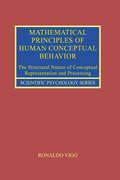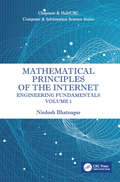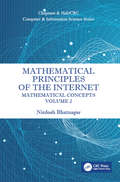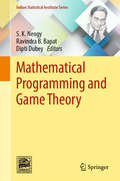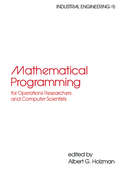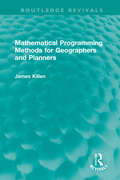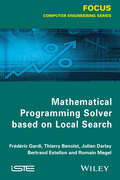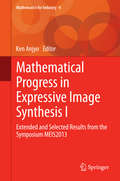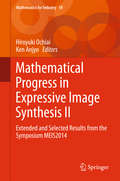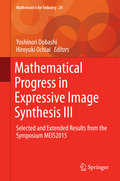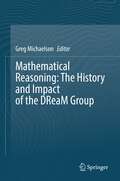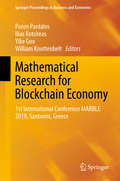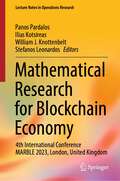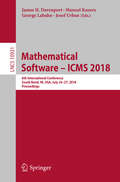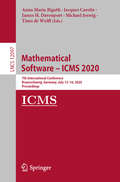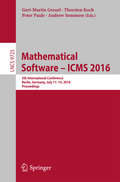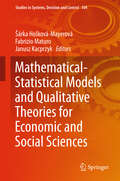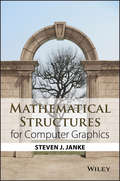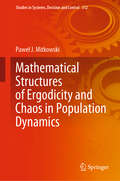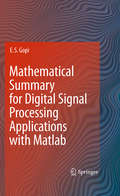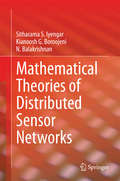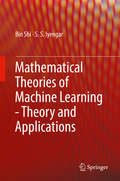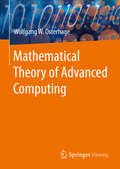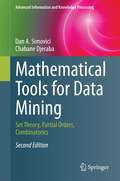- Table View
- List View
Mathematical Principles of Human Conceptual Behavior: The Structural Nature of Conceptual Representation and Processing (Scientific Psychology Series)
by Ronaldo VigoThe ability to learn concepts lies at the very core of human cognition, enabling us to efficiently classify, organize, identify, and store complex information. In view of the basic role that concepts play in our everyday physical and mental lives, the fields of cognitive science and psychology face three long standing challenges: discovering the laws that govern concept learning and categorization behavior in organisms, showing how they inform other areas of cognitive research, and describing them with the mathematical systematicity and precision found in the physical sciences. In light of these theoretical and methodological shortcomings, this volume will introduce a set of general mathematical principles for predicting and explaining conceptual behavior. The author’s theory is based on seven fundamental constructs of universal science: invariance, complexity, information, similarity, dissimilarity, pattern, and representation. These constructs are joined by a novel mathematical framework that does not depend on probability theory, and derives key results from conceptual behavior research with other key areas of cognitive research such as pattern perception, similarity assessment, and contextual choice. The result is a unique and systematic unifying foundation for cognitive science in the tradition of classical physics.
Mathematical Principles of the Internet, Volume 1: Engineering (Chapman & Hall/CRC Computer and Information Science Series)
by Nirdosh BhatnagarThis two-volume set on Mathematical Principles of the Internet provides a comprehensive overview of the mathematical principles of Internet engineering. The books do not aim to provide all of the mathematical foundations upon which the Internet is based. Instead, they cover a partial panorama and the key principles. Volume 1 explores Internet engineering, while the supporting mathematics is covered in Volume 2. The chapters on mathematics complement those on the engineering episodes, and an effort has been made to make this work succinct, yet self-contained. Elements of information theory, algebraic coding theory, cryptography, Internet traffic, dynamics and control of Internet congestion, and queueing theory are discussed. In addition, stochastic networks, graph-theoretic algorithms, application of game theory to the Internet, Internet economics, data mining and knowledge discovery, and quantum computation, communication, and cryptography are also discussed. In order to study the structure and function of the Internet, only a basic knowledge of number theory, abstract algebra, matrices and determinants, graph theory, geometry, analysis, optimization theory, probability theory, and stochastic processes, is required. These mathematical disciplines are defined and developed in the books to the extent that is needed to develop and justify their application to Internet engineering.
Mathematical Principles of the Internet, Volume 2: Mathematics (Chapman & Hall/CRC Computer and Information Science Series)
by Nirdosh BhatnagarThis two-volume set on Mathematical Principles of the Internet provides a comprehensive overview of the mathematical principles of Internet engineering. The books do not aim to provide all of the mathematical foundations upon which the Internet is based. Instead, they cover a partial panorama and the key principles. Volume 1 explores Internet engineering, while the supporting mathematics is covered in Volume 2. The chapters on mathematics complement those on the engineering episodes, and an effort has been made to make this work succinct, yet self-contained. Elements of information theory, algebraic coding theory, cryptography, Internet traffic, dynamics and control of Internet congestion, and queueing theory are discussed. In addition, stochastic networks, graph-theoretic algorithms, application of game theory to the Internet, Internet economics, data mining and knowledge discovery, and quantum computation, communication, and cryptography are also discussed. In order to study the structure and function of the Internet, only a basic knowledge of number theory, abstract algebra, matrices and determinants, graph theory, geometry, analysis, optimization theory, probability theory, and stochastic processes, is required. These mathematical disciplines are defined and developed in the books to the extent that is needed to develop and justify their application to Internet engineering.
Mathematical Programming and Game Theory (Indian Statistical Institute Series)
by S. K. Neogy Ravindra B. Bapat Dipti DubeyThis book discusses recent developments in mathematical programming and game theory, and the application of several mathematical models to problems in finance, games, economics and graph theory. All contributing authors are eminent researchers in their respective fields, from across the world. This book contains a collection of selected papers presented at the 2017 Symposium on Mathematical Programming and Game Theory at New Delhi during 9–11 January 2017. Researchers, professionals and graduate students will find the book an essential resource for current work in mathematical programming, game theory and their applications in finance, economics and graph theory. The symposium provides a forum for new developments and applications of mathematical programming and game theory as well as an excellent opportunity to disseminate the latest major achievements and to explore new directions and perspectives.
Mathematical Programming for Operations Researchers and Computer Scientists
by Albert G. HolzmanThis book covers the fundamentals of linear programming, extension of linear programming to discrete optimization methods, multi-objective functions, quadratic programming, geometric programming, and classical calculus methods for solving nonlinear programming problems.
Mathematical Programming Methods for Geographers and Planners (Routledge Revivals)
by James KillenOriginally published in 1983, this was the first text to offer an in-depth treatment of mathematical programming methods explained from first principles. It considers all the major programming techniques and fully explains key terms, illustrates theories with detailed examples and shows how the various skills are applied in practice. It will be invaluable in both the academic world and to policy formulators and planners, who make extensive use of the methods described.
Mathematical Programming Solver Based on Local Search
by Frédéric Gardi Thierry Benoist Julien Darlay Bertrand Estellon Romain MegelThis book covers local search for combinatorial optimization and its extension to mixed-variable optimization. Although not yet understood from the theoretical point of view, local search is the paradigm of choice for tackling large-scale real-life optimization problems. Today's end-users demand interactivity with decision support systems. For optimization software, this means obtaining good-quality solutions quickly. Fast iterative improvement methods, like local search, are suited to satisfying such needs. Here the authors show local search in a new light, in particular presenting a new kind of mathematical programming solver, namely LocalSolver, based on neighborhood search. First, an iconoclast methodology is presented to design and engineer local search algorithms. The authors' concern regarding industrializing local search approaches is of particular interest for practitioners. This methodology is applied to solve two industrial problems with high economic stakes. Software based on local search induces extra costs in development and maintenance in comparison with the direct use of mixed-integer linear programming solvers. The authors then move on to present the LocalSolver project whose goal is to offer the power of local search through a model-and-run solver for large-scale 0-1 nonlinear programming. They conclude by presenting their ongoing and future work on LocalSolver toward a full mathematical programming solver based on local search.
Mathematical Progress in Expressive Image Synthesis I
by Ken AnjyoThis book presents revised versions of the best papers selected from the symposium "Mathematical Progress in Expressive Image Synthesis" (MEIS2013) held in Fukuoka, Japan, in 2013. The topics cover various areas of computer graphics (CG), such as surface deformation/editing, character animation, visual simulation of fluids, texture and sound synthesis and photorealistic rendering. From a mathematical point of view, the book also presents papers addressing discrete differential geometry, Lie theory, computational fluid dynamics, function interpolation and learning theory. This book showcases the latest joint efforts between mathematicians, CG researchers and practitioners exploring important issues in graphics and visual perception. The book provides a valuable resource for all computer graphics researchers seeking open problem areas, especially those now entering the field who have not yet selected a research direction.
Mathematical Progress in Expressive Image Synthesis II
by Hiroyuki Ochiai Ken AnjyoThe material included in this book provides selected presentations given at the international symposium MEIS2014. The book aims to provide a unique venue where various issues in computer graphics (CG) application fields are discussed by mathematicians as well as CG researchers and practitioners. The target audience is not limited to researchers in academia but also those in industries with a strong interest in digital media creation, scientific visualization and visual engineering.
Mathematical Progress in Expressive Image Synthesis III
by Yoshinori Dobashi Hiroyuki Ochiai"Progress in Expressive Image Synthesis"(MEIS2015), was held in Fukuoka, Japan, September 25-27, 2015. The aim of thesymposium was to provide a unique venue where various issues in computergraphics (CG) application fields could be discussed by mathematicians, CGresearchers, and practitioners. Through the previous symposiums MEIS2013 andMEIS2014, mathematicians as well as CG researchers have recognized that CG is aspecific and practical activity derived from mathematical theories. Issuesfound in CG broaden the field of mathematics and vice versa, and CG visualizesmathematical theories in an aesthetic manner. In this volume, the editors aim toprovoke interdisciplinary research projects through the peer-reviewed papersand poster presentations at the this year's symposium. This book capturesinteractions among mathematicians, CG researchers, and practitioners sharingimportant, state-of-the-art issues in graphics and visual perception. The bookis suitable for all CG researchers seeking open problem areas and especiallyfor those entering the field who have not yet selected a research direction.
Mathematical Reasoning: The History and Impact of the DReaM Group
by Greg MichaelsonThis collection of essays examines the key achievements and likely developments in the area of automated reasoning. In keeping with the group ethos, Automated Reasoning is interpreted liberally, spanning underpinning theory, tools for reasoning, argumentation, explanation, computational creativity, and pedagogy. Wider applications including secure and trustworthy software, and health care and emergency management. The book starts with a technically oriented history of the Edinburgh Automated Reasoning Group, written by Alan Bundy, which is followed by chapters from leading researchers associated with the group. Mathematical Reasoning: The History and Impact of the DReaM Group will attract considerable interest from researchers and practitioners of Automated Reasoning, including postgraduates. It should also be of interest to those researching the history of AI.
Mathematical Research for Blockchain Economy: 1st International Conference MARBLE 2019, Santorini, Greece (Springer Proceedings in Business and Economics)
by Panos Pardalos Ilias Kotsireas William Knottenbelt Yike GuoThis book presents the best papers from the 1st International Conference on Mathematical Research for Blockchain Economy (MARBLE) 2019, held in Santorini, Greece. While most blockchain conferences and forums are dedicated to business applications, product development or Initial Coin Offering (ICO) launches, this conference focused on the mathematics behind blockchain to bridge the gap between practice and theory. Every year, thousands of blockchain projects are launched and circulated in the market, and there is a tremendous wealth of blockchain applications, from finance to healthcare, education, media, logistics and more. However, due to theoretical and technical barriers, most of these applications are impractical for use in a real-world business context. The papers in this book reveal the challenges and limitations, such as scalability, latency, privacy and security, and showcase solutions and developments to overcome them.
Mathematical Research for Blockchain Economy: 4th International Conference MARBLE 2023, London, United Kingdom (Lecture Notes in Operations Research)
by Panos Pardalos Ilias Kotsireas William J. Knottenbelt Stefanos LeonardosThis book presents the best papers from the 4th International Conference on Mathematical Research for Blockchain Economy (MARBLE) 2023, held in London, UK. While most blockchain conferences and forums are dedicated to business applications, product development, or Initial Coin Offering (ICO) launches, this conference focused on the mathematics behind blockchain to bridge the gap between practice and theory. The book spans the divide between theoretical promise and practical reality in blockchain technology and explores the challenges hindering its real-world integration across diverse sectors, offering comprehensive insights into issues like scalability, security, and privacy.
Mathematical Software – ICMS 2018: 6th International Conference, South Bend, IN, USA, July 24-27, 2018, Proceedings (Lecture Notes in Computer Science #10931)
by James H. Davenport Manuel Kauers George Labahn Josef UrbanThis book constitutes the proceedings of the 6th International Conference on Mathematical Software, ICMS 2018, held in South Bend, IN, USA, in July 2018.The 59 papers included in this volume were carefully reviewed and selected from numerous submissions. The program of the 2018 meeting consisted of 20 topical sessions, each of which providing an overview of the challenges, achievements and progress in a subeld of mathematical software research, development and use.
Mathematical Software – ICMS 2020: 7th International Conference, Braunschweig, Germany, July 13–16, 2020, Proceedings (Lecture Notes in Computer Science #12097)
by Anna Maria Bigatti Jacques Carette James H. Davenport Michael Joswig Timo De WolffThis book constitutes the proceedings of the 7th International Conference on Mathematical Software, ICMS 2020, held in Braunschweig, Germany, in July 2020. The 48 papers included in this volume were carefully reviewed and selected from 58 submissions. The program of the 2020 meeting consisted of 20 topical sessions, each of which providing an overview of the challenges, achievements and progress in a environment of mathematical software research, development and use.
Mathematical Software - ICMS 2016
by Gert-Martin Greuel Thorsten Koch Peter Paule Andrew SommeseThis book constitutes the proceedings of the 5th International Conference on Mathematical Software, ICMS 2015, held in Berlin, Germany, in July 2016. The 68 papers included in this volume were carefully reviewed and selected from numerous submissions. The papers are organized in topical sections named: univalent foundations and proof assistants; software for mathematical reasoning and applications; algebraic and toric geometry; algebraic geometry in applications; software of polynomial systems; software for numerically solving polynomial systems; high-precision arithmetic, effective analysis, and special functions; mathematical optimization; interactive operation to scientific artwork and mathematical reasoning; information services for mathematics: software, services, models, and data; semDML: towards a semantic layer of a world digital mathematical library; miscellanea.
Mathematical-Statistical Models and Qualitative Theories for Economic and Social Sciences
by Janusz Kacprzyk Fabrizio Maturo Šárka Hošková-MayerováThis book presents a broad spectrum of problems related to statistics, mathematics, teaching, social science, and economics as well as a range of tools and techniques that can be used to solve these problems. It is the result of a scientific collaboration between experts in the field of economic and social systems from the University of Defence in Brno (Czech Republic), G. d'Annunzio University of Chieti-Pescara (Italy), Pablo de Olavid eUniversity of Sevilla (Spain), and Ovidius University in Constanţa, (Romania). The studies included were selected using a peer-review process and reflect heterogeneity and complexity of economic and social phenomena. They and present interesting empirical research from around the globe and from several research fields, such as statistics, decision making, mathematics, complexity, psychology, sociology and economics. The volume is divided into two parts. The first part, "Recent trends in mathematical and statistical models for economic and social sciences", collects papers on quantitative matters, which propose mathematical and statistical models for social sciences, economics, finance, and business administration. The second part, "Recent trends in qualitative theories for economic and social sciences", includes papers on qualitative matters, which discuss social, economic, and teaching issues. It is an ideal reference work for all those researchers interested in recent quantitative and qualitative tools. Covering a wide range of topics, it appeals in equal measure to mathematicians, statisticians, sociologists, philosophers, and specialists in the fields of communication, social and political sciences.
Mathematical Structures for Computer Graphics
by Steven J. JankeA comprehensive exploration of the mathematics behind the modeling and rendering of computer graphics scenesMathematical Structures for Computer Graphics presents an accessible and intuitive approach to the mathematical ideas and techniques necessary for two- and three-dimensional computer graphics. Focusing on the significant mathematical results, the book establishes key algorithms used to build complex graphics scenes.Written for readers with various levels of mathematical background, the book develops a solid foundation for graphics techniques and fills in relevant graphics details often overlooked in the literature. Rather than use a rigid theorem/proof approach, the book provides a flexible discussion that moves from vector geometry through transformations, curve modeling, visibility, and lighting models. Mathematical Structures for Computer Graphics also includes:Numerous examples of two- and three-dimensional techniques along with numerical calculationsPlenty of mathematical and programming exercises in each chapter, which are designed particularly for graphics tasksAdditional details at the end of each chapter covering historical notes, further calculations, and connected concepts for readers who wish to delve deeperUnique coverage of topics such as calculations with homogeneous coordinates, computational geometry for polygons, use of barycentric coordinates, various descriptions for curves, and L-system techniques for recursive imagesMathematical Structures for Computer Graphics is an excellent textbook for undergraduate courses in computer science, mathematics, and engineering, as well as an ideal reference for practicing engineers, researchers, and professionals in computer graphics fields. The book is also useful for those readers who wish to understand algorithms for producing their own interesting computer images.
Mathematical Structures of Ergodicity and Chaos in Population Dynamics (Studies in Systems, Decision and Control #312)
by Paweł J. MitkowskiThis book concerns issues related to biomathematics, medicine, or cybernetics as practiced by engineers. Considered population dynamics models are still in the interest of researchers, and even this interest is increasing, especially now in the time of SARS-CoV-2 coronavirus pandemic, when models are intensively studied in order to help predict its behaviour within human population. The structures of population dynamics models and practical methods of finding their solutions are discussed. Finally, the hypothesis of the existence of non-trivial ergodic properties of the model of erythropoietic response dynamics formulated by A. Lasota in the form of delay differential equation with unimodal feedback is analysed. The research can be compared with actual medical data, as well as shows that the structures of population models can reflect the dynamic structures of reality.
Mathematical Summary for Digital Signal Processing Applications with Matlab
by E. S. GopiMathematical summary for Digital Signal Processing Applications with Matlab consists of Mathematics which is not usually dealt in the DSP core subject, but used in DSP applications. Matlab programs with illustrations are given for the selective topics such as generation of Multivariate Gaussian distributed sample outcomes, Bacterial foraging algorithm, Newton's iteration, Steepest descent algorithm, etc. are given exclusively in the separate chapter. Also Mathematical summary for Digital Signal Processing Applications with Matlab is written in such a way that it is suitable for Non-Mathematical readers and is very much suitable for the beginners who are doing research in Digital Signal Processing.
Mathematical Theories of Distributed Sensor Networks
by Sitharama S. Iyengar Kianoosh G. Boroojeni N. BalakrishnanThis book provides a Mathematical Theory of Distributed Sensor Networks. It introduces the Mathematical & Computational Structure by discussing what they are, their applications and how they differ from traditional systems. It also explains how mathematics are utilized to provide efficient techniques implementing effective coverage, deployment, transmission, data processing, signal processing, and data protection within distributed sensor networks. Finally, it discusses some important challenges facing mathematics to get more incite to the multidisciplinary area of distributed sensor networks. -This book will help design engineers to set up WSN-based applications providing better use of resources while optimizing processing costs. -This book is highly useful for graduate students starting their first steps in research to apprehend new approaches and understand the mathematics behind them and face promising challenges. -This book aims at presenting a formal framework allowing to show how mathematical theories can be used to provide distributed sensor modeling and to solve important problems such as coverage hole detection and repair. -This book aims at presenting the current state of the art in formal issues related to sensor networking. It can be used as a handbook for different classes at the graduate level and the undergraduate level. It is self contained and comprehensive, presenting a complete picture of the discipline of optical network engineering including modeling functions, controlling quality of service, allocation resources, monitoring traffic, protecting infrastructure, and conducting planning. This book addresses a large set of theoretical aspects. It is designed for specialists in ad hoc and wireless sensor networks and does not include discusses on very promising areas such as homotopy, computational geometry, and wavelet transforms.
Mathematical Theories of Machine Learning - Theory and Applications
by Bin Shi S. S. IyengarThis book studies mathematical theories of machine learning. The first part of the book explores the optimality and adaptivity of choosing step sizes of gradient descent for escaping strict saddle points in non-convex optimization problems. In the second part, the authors propose algorithms to find local minima in nonconvex optimization and to obtain global minima in some degree from the Newton Second Law without friction. In the third part, the authors study the problem of subspace clustering with noisy and missing data, which is a problem well-motivated by practical applications data subject to stochastic Gaussian noise and/or incomplete data with uniformly missing entries. In the last part, the authors introduce an novel VAR model with Elastic-Net regularization and its equivalent Bayesian model allowing for both a stable sparsity and a group selection.
Mathematical Theory of Advanced Computing (It Kompakt Ser.)
by Wolfgang W. OsterhageThis book deals with computer performance by addressing basic preconditions. Besides general considerations about performance, several new approaches are presented. One of them targets memory structures by introducing the possibility of overlapping non-interfering (virtual) address spaces. This approach is based on a newly developed jump transformation between different symbol spaces. Another approach deals with efficiency and accuracy in scientific calculations. Finally the concept of a Neural Relational Data Base Management System is introduced and the performance potential of quantum computers assessed.
Mathematical Tools for Data Mining
by Dan A. Simovici Chabane DjerabaData mining essentially relies on several mathematical disciplines, many of which are presented in this second edition of this book. Topics include partially ordered sets, combinatorics, general topology, metric spaces, linear spaces, graph theory. To motivate the reader a significant number of applications of these mathematical tools are included ranging from association rules, clustering algorithms, classification, data constraints, logical data analysis, etc. The book is intended as a reference for researchers and graduate students. The current edition is a significant expansion of the first edition. We strived to make the book self-contained and only a general knowledge of mathematics is required. More than 700 exercises are included and they form an integral part of the material. Many exercises are in reality supplemental material and their solutions are included.
The Mathematical Tourist: New and Updated Snapshots of Modern Mathematics
by Ivars PetersonTo most outsiders, modern mathematics represents unknown territory. Few realize that the world of modern mathematics is rich with vivid images, provocative ideas, and useful notions. The revised, updated book also includes new material about the structure of crystals and about discoveries illuminating the relationship between four-dimensional geometry and physical theories of the nature of time, space, and matter. It adds the application of cellular automata models to social questions and to the peregrinations of virtual ants. It extends the discussion of applications of fractals and introduces the notion of controlling chaos. A greatly expanded concluding chapter on the nature of mathematical proof includes accounts of Turing machines, transparent proofs, and how a computer program managed to prove a long-standing mathematical conjecture. It ends with the dramatic unveiling of a proof by Andrew Wiles of Fermat's last theorem.
